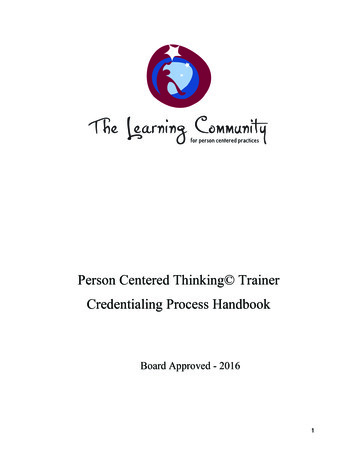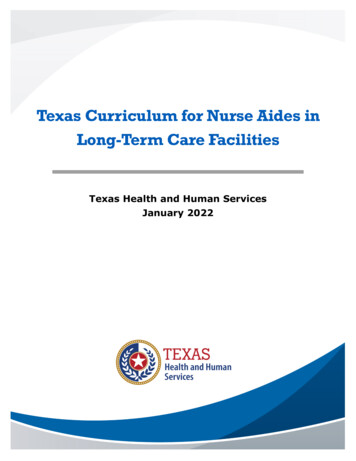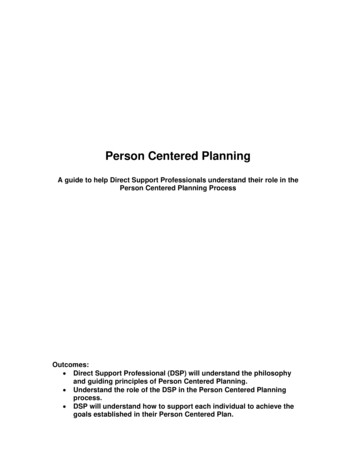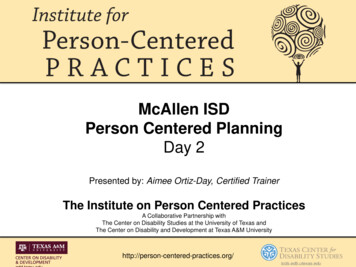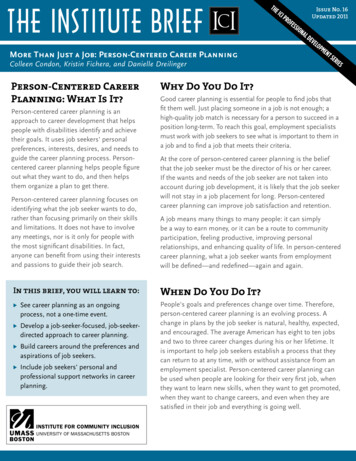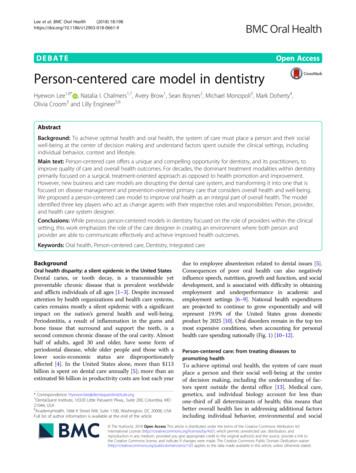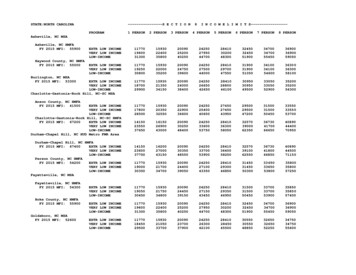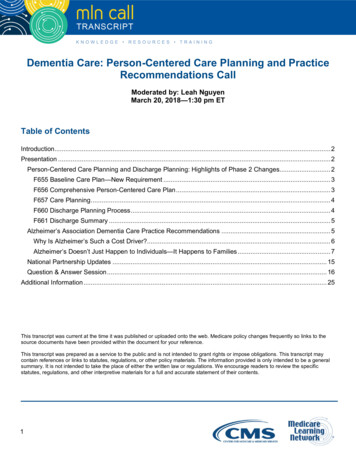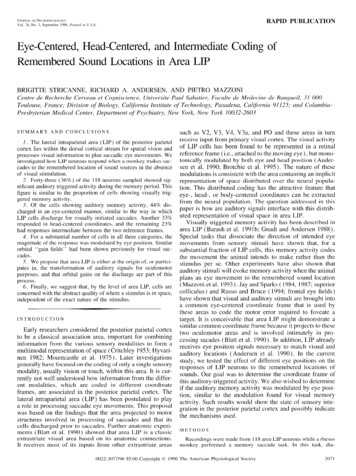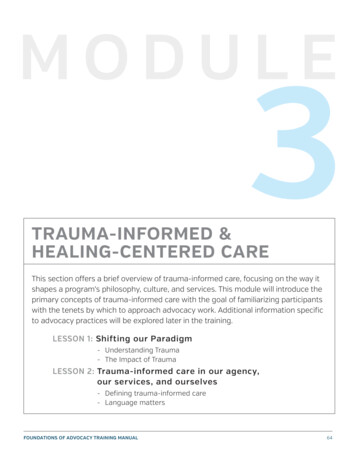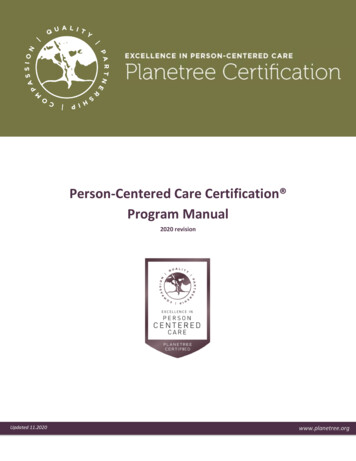
Transcription
Person-Centered Care Certification Program Manual2020 revisionUpdated 11.2020www.planetree.org
Copyright 2020, Planetree International. All rights reserved.Suggested Citation:Planetree International, Inc. Person-Centered Care Certification Manual. Derby, CT: Planetree International, 2020.For Additional Information:www.planetree.orgThis document replaces the following two documents (and any earlier iterations): Planetree Designation Process Manual, 2014-2015 Planetree International Designation Process Manual, 2016-2017About Planetree InternationalPlanetree International is a mission based not-for-profit organization that has partnered with over 800 healthcareorganizations in 30 countries and across the care continuum to create cultures of person-centered care. Poweredby over 50,000 focus group attendees comprised of patients, families, and staff, and more than 40- years ofexperience working with healthcare organizations, the Planetree approach emphasizes the quality of humaninteractions and caring communication, the importance of connecting healthcare personnel to the deeper purposeof their work, and practical strategies for engaging patients and family members as true partners in care. Theseelements have been consolidated into the Person-Centered Care Certification Program, which providesorganizations with a structured process to guide culture change efforts that yield improvements in clinical,operational and patient experience outcomes. As a person-centered care advocacy organization, PlanetreeInternational promotes respect, inclusion, and compassion toward all who interact with healthcare systems.Planetree’s core philosophy of kindness, caring and respect seeks to humanize healthcare around the world.www.planetree.org Planetree International 2020. All Rights Reserved.Person-Centered Care Certification Program Manual2
AcknowledgementsPlanetree International is grateful to all of the healthcare organizations and professionals who have contributed tothe development of the Person-Centered Care Certification Program over the years, and in particular as it hasevolved from Version 1.0 (Patient-Centered Designation) to Version 2.0 (Person-Centered Care Certification). Inparticular, we would like to acknowledge the following individuals and groups for their contributions: Members of the Designation Advisory Committee who spearheaded the program’s multi-year pilot phase All those who have served terms on the International Person-Centered Care Certification Committee andhave provided vital guidance in the development and interpretation of the program elements Planetree International staff and partners who have implemented the program All of the patients, long-term care residents, family members, design professionals and professionalcaregivers at healthcare organizations across the continuum of care and around the world who haveparticipated in the program, and whose insights over the years have largely informed the criteria that set astandard for excellence in the delivery of person-centered care.This document, and specifically the revised criteria and measurable elements for Version 2.0 introduced here, weredeveloped as part of a collaborative process spearheaded by the Designation Reconstruction Advisory Council, aninternational and multi-stakeholder group that included patient and family advocates, healthcare executives,practitioners, Planetree staff, board members and international partners. This group met monthly betweenSeptember 2016 and February 2017 and provided significant input into the program revisions. Membersunanimously endorsed the criteria revisions in March 2017.Designation Reconstruction Advisory Council Members:Marita Bossers-Nabben, Directueur, Planetree NetherlandsMarie-Michèle Brodeur D.Ps., Director of Knowledge, Reseau Planetree QuebecChristy Davies, Manager of Certification, Planetree InternationalMaria De Pena-Nowak, MD, Chief, Evaluation and Emergency Psychiatric Services, New York Presbyterian HospitalWestchester DivisionSusan Frampton, PhD, President, Planetree InternationalLisa Freeman, member, Planetree International Patient and Family Partnership Council; Executive Director,Connecticut Center for Patient SafetySara Guastello, Director of Knowledge Management, Planetree InternationalChristina Gunther-Murphy, Executive Director, Institute for Healthcare ImprovementJill Harrison, PhD, Director of Research, Planetree InternationalAndrew McCulloch, PhD, Chief Executive (Retired), Picker Institute Europe*Anne Rooney, Global Healthcare Consultant and President, Anne Rooney & AssociatesJoel Seligman, President and CEO, Northern Westchester HospitalAnne Snijder, Services and Consultant Planetree NetherlandsEtel Veringa, General Director, Planetree América Latina* Retired from committee prior to criteria endorsement vote Planetree International 2020. All Rights Reserved.Person-Centered Care Certification Program Manual1
Table of ContentsBackground .3Introducing Version 2.0: Person-Centered Care Certification .5Program Terminology .8Person-Centered Care Certification Program Elements .9Process Overview: Step by Step Guide to Applying for Certification .14The Lived Experience Validation Assessment .17Person-Centered Care Certification Criteria and Measurable Elements .21Program Guidelines and Policies .71Appendix A. Glossary of Terms .75Appendix B. Criteria Breakdown – Sequentially .78Appendix C. Criteria Breakdown – By Point Value.81Appendix D. Partnership Portfolio Worksheet .84Appendix E. Healthy Community Portfolio Worksheet .85Appendix F. Transitions of Care Portfolio Worksheet .86Appendix G. Improvement Portfolio Worksheet .87Appendix H. Tips for Recruiting Focus Group Participants .89 Planetree International 2020. All Rights Reserved.Person-Centered Care Certification Program Manual2
1. BackgroundIn 2001, the landmark Institute of Medicine (IOM) Committee report, Crossing the Quality Chasm identified“patient-centeredness” as one of six key determinants of high-quality healthcare, alongside safety, effectiveness,efficiency, equity, and timeliness. Patient-centered care was defined by the IOM as “care that is respectful of andresponsive to individual patient preferences, needs, and values, and ensuring that patient values guide all clinicaldecisions.” Another widely embraced definition emerged from the World Health Organization: “An approach thatconsciously adopts the perspectives of individuals, families and communities and sees them as participants as wellas beneficiaries of trusted health systems that respond to their needs and preferences in human and holisticways.”Since then, important strides have been made and have built on one another to accelerate adoption of what isnow widely referred to as “person-centered care.” (See page 6 for more on this.) The concept has beenincorporated into healthcare policy and reimbursement models. It has sparked the interest of researchers whohave studied the impact of person-centered approaches on outcomes, and it has fueled the emergence of patientexperience officers and patient and family advisors in healthcare centers around the world. Person-centered carealso gained prominence in organizations’ mission statements, marketing efforts and web sites.However, in the absence of a common understanding of the critical elements necessary to implement and sustainan organizational culture of person-centered care, person-centeredness remained more of an elusive aspirationalstate than a concrete goal that could be set, measured and attained.In 2007, following a multi-year development and testing period, Planetree International introduced the Patient/Resident-Centered Designation Program to address this gap between aspirations and actions necessary to createa more person-centered healthcare system. The program provides a structured, operational framework forevaluating the systems and processes necessary to sustain organizational culture change. Through a rigorousvalidation process that engages patients, their families and caregivers, the program recognizes healthcare organizations and providers that have achieved superior levels of practice of person-centered care. The program’sframework has been implemented in settings across the continuum of care and in 23 countries worldwide.In the 13 years since the Designation Program was launched, progress has continued toward the goal of creating amore person-centered healthcare system. This work included the January 2017 release of a discussion paper bythe National Academy of Medicine (formerly the Institute of Medicine) that introduced a new definition:“Care planned, delivered, managed, and continuously improved in active partnership with patientsand their families (or care partners as defined by the patient) to ensure integration of their health andhealthcare goals, preferences, and values. It includes explicit and partnered determination of goalsand care options, and it requires ongoing assessment of the care match with patient goals.”This new definition derives heavily from the IOM’s 2001 definition but is much more explicit in emphasizing thepartnership between patients, families, and their clinical team. By highlighting “partnered determination of goalsand care options,” this new definition advances understanding of person-centered care as going beyond workingfor patients and families to working with them – not only in designing their care at the personal level and incontinuous improvement at the organizational level, but also in defining the outcomes that matter most to them.This is a fundamental shift in the orientation of many healthcare processes and practices. Planetree International 2020. All Rights Reserved.Person-Centered Care Certification Program Manual3
To recognize this shift, a new term was introduced – patient and family engaged care. For the purposes of thisdocument and throughout the Person-Centered Care Certification Program which aims to provide support foroperationalizing these concepts of patient and family engagement, this is the definition Planetree feels bestcaptures the broad range of practices, methods and approaches that encompass a culture of person-centered care.1.1.Key Program Elements Criteria – The set of standards that delineate the critical elements necessary to implement and sustain anorganizational culture of person-centered care. The criteria are intended to provide a level of consistencyin what it means to be person-centered, while continuing to promote individuality and innovation in thedelivery of care. The criteria are designed to be applicable to any organization across the healthcarecontinuum, irrespective of size, location, or formal affiliation with Planetree. Validation via Documentation and the Lived Experience – Person-Centered Care Certification is conferredbased on a variety of factors, including:o A written application wherein applicants attest to ways in which their organization’s currentactivities satisfy the intent of the criteria;o Review of policy and process documents;o Performance on key organizational indicators related to person-centered care; ando How those who interface with the organization (patients, family members, staff) assess theperson-centered culture.Fundamental to the evaluation process are focus groups or interviews with patients (and residents inlong-term care settings) and family members, as well as with the organization’s personnel. These focusgroups and interviews elevate the voices of these key stakeholders as an integral part of the assessmentof the organization’s person-centered culture. This unique feature of the Person-Centered CareCertification Program ensures that certification is not conferred based solely on documentation but basedon the experiences of real people in real circumstances. Recognition Tiers – In 2011, intermediate recognition tiers were introduced to the program to provideinterim opportunities for recognition for organizations working toward the highest level of recognition.The tiers each represent incremental levels of achievement. See page 12 for more on these recognitiontiers. Planetree International 2020. All Rights Reserved.Person-Centered Care Certification Program Manual4
2. Introducing Version 2.0: Person-Centered Care Certification Guided by the voices of patient and family partners and healthcare professionals across the continuum, Version2.0 redesign of the program was introduced in 2018. This effort signaled the most significant improvement effortsince the program’s launch more than a decade prior. What remains the same, however, are the program’soverarching goals, which have guided every decision and improvement effort in its evolution.2.1.Program Goals To define the key elements needed to implement and sustain organizational cultures of person-centered care To provide a concrete framework for implementation; and To confer external validation and recognition that differentiates healthcare organizations demonstratingsuperior levels of achievement in person-centered care2.2.About the Program Redesign ProcessThe program redesign was guided by the Designation Reconstruction Advisory Council, an international and multistakeholder group that included patient and family advocates, healthcare executives, practitioners, Planetree staff,board members and international partners. This group met monthly between September 2016 and February 2017and provided significant input into the program revisions. Members unanimously endorsed the criteria revisions inMarch 2017. A list of members of this group is listed on page 1 of this manual.In addition to the members of this advisory group, additional input was solicited during the development phasefrom a broad population of stakeholders via: A public comment period from January-February 2017 to solicit input on the draft criteria revisions Staff and International Partner feedback sessions Education and feedback sessions with representatives of Designated sites Small scale tests to operationally vet proposed process changes.All of this input significantly influenced the development of Version 2.0 of the Person-Centered Care CertificationProgram, and Planetree extends its deep appreciation to all those who contributed their time, insights, andperspectives in this important work of defining what it takes to achieve person-centered excellence.Another important source of guidance for the program redesign effort was the International Society for Quality inHealthcare (ISQua) International Accreditation Programme’s (IAP) Guidelines and Principles for the Development ofHealth and Social Care Standards, 4th Edition (September 2015) and Guidelines and Standards for ExternalEvaluation Organisations, 4th Edition (September 2015). These standards provided direction for aligning the PersonCentered Care Certification standards and evaluation process with internationally accepted best practices inexternal evaluation services. Planetree International 2020. All Rights Reserved.Person-Centered Care Certification Program Manual5
2.3.Program Redesign Areas of FocusThe program redesign was guided by these four primary improvement strategies:1.Re-organize and consolidate the criteria to emphasize the most high-leverage changes2.Introduce a more transparent and logical scoring system for rating organizational performance3.Promote greater flexibility in how organizations may meet the spirit and intent of the criteria4.Redistribute performance expectations across the recognition tiers to expand opportunities fororganizations to earn recognition for their progress.2.4.From Patient-Centered Designation to Person-Centered Care CertificationAmong the changes being introduced as part of the program redesign is a renaming of the program from thePatient-Centered Designation Program to the Person-Centered Certification Program.Why Person-Centered?This fairly subtle shift in terminology from “patient-centered” to “person-centered” is in line with an approach tohealthcare that treats individuals as more than a sum of their body parts and medical conditions.When it comes to how individuals view themselves and how they want to be viewed by others, rarely is “patient”the primary definer of their identity. They are multi-dimensional human beings, whose care should be provided ina holistic may to address their full range of their needs, preferences, and experiences. In other words, it is anapproach that focuses on the person first.Furthermore, to truly promote health, wellness, and holistic care, we must look beyond an individual’s healthhistory and their list of complaints and symptoms to consider their experiences outside of the healthcare deliverysystem. Better understanding the social determinants of an individual’s health is an integral component of personcentered care.Finally, adoption of this terminology better captures the inclusiveness of person-centered care. A person-centeredculture is not built solely around the patient experience and the needs and preferences of patients, but also mustaddress the experiences and needs of family members, as well as of healthcare professionals.Why Certification?The program has been restructured as a certification program to minimize confusion in the marketplace created byPlanetree’s previous use of the term designation, which was not widely understood. The term certification is moreuniversally recognized for the kind of structured, standards-based quality improvement framework that thisprogram provides.2.5. What is New in Version 2.0?The criteria that delineate the critical elements for achieving excellence in person-centered care havebeen significantly re-organized and consolidated. The new set of criteria narrows in on the most highleverage, evidence-based changes tied to what matters most to patients, families, and healthcare Planetree International 2020. All Rights Reserved.Person-Centered Care Certification Program Manual6
personnel. The revised set includes 26 criteria across five drivers, compared to 66 criteria across 11domains in Version 1.0 of the program. Measurable elements have been associated with each of the criteria. These indicators provide explicitguidance on how an applicant will be measured or rated on each criterion. A quantifiable scoring system has been developed to measure achievement logically and consistently. Thescoring system is based on numerical points associated with each measurable element. The evaluation methodology has been designed to ensure that evidence derived from the “livedexperience” (for instance, focus groups, observation, discussion, etc.) continues to be the most heavilyweighted component of the certification score. The performance levels associated with each recognition tier have been adjusted, with defined scoringranges corresponding with each. In Version 2.0, the recognition levels are defined by the number ofpoints earned by an applicant site. The levels of recognition are: Planetree Certified Bronze (96 – 119 points). Or at least 60% of the total available points. Planetree Certified Silver (120 - 143 points). Or 75%-89% of the total available points. Planetree Certified Gold (144 points or more). Or 90% or more of the total available points The introduction of an online application (available at https://application.planetree.org/) will enhance theapplicant experience and reduce the administrative burden of applying. A glossary of terms that appear in the criteria and measurable elements has been developed to promotecommon understanding and interpretation of the terms.2.6.New Certification BadgesIn conjunction with the roll-out of the PersonCentered Care Certification Program, in 2018 newrecognition badges will be introduced to reflect thenew person-centered certification languageadopted in Version 2.0. In addition, to betterleverage the badges to communicate to the publicwhat the achievement of Person-Centered CareCertification means, language has beenincorporated into the design that conveys theessence of person-centered care in three words:Quality, Compassion, Partnership. Planetree International 2020. All Rights Reserved.Person-Centered Care Certification Program Manual7
3. Program TerminologyThe following terms are used in the program overview. For consistent understanding, they are defined below.Criteria:The standards organizations are held to. Each of the 26 criteria is broken downinto measurable elements which establish a more operational understanding ofwhat it takes to demonstrate that the spirit and intent of the criterion is beingmet.Documentation Evidence:Evidence provided in writing as part of the application process.Drivers:A high level depiction of what it takes to create and maintain a culture ofperson-centered care. The criteria are organized into 5 drivers: Create organizational structures that promote engagement Connect values, strategies, and action Implement practices that promote partnership Know what matters Use evidence to drive improvementLived Experience Evidence:Evidence that can only be acquired from interacting directly with stakeholders.Approaches used to gather this lived experience evidence include focus groups,interviews, meetings, and structured observation.Measurable Elements:An explicit accounting of the operational requirements needed to fully satisfyeach criterion. Each measurable element is associated with a numerical pointvalue.Person-Centered Care:“Care planned, delivered, managed, and continuously improved in activepartnership with patients and their families (or care partners as defined by thepatient) to ensure integration of their health and healthcare goals, preferences,and values. It includes explicit and partnered determination of goals and careoptions, and it requires ongoing assessment of the care match with patientgoals.” (National Academy of Medicine, 2017)Provisional Score:Points awarded to a site based on the documentation evidence submitted.Points remain provisional until validated through lived experience evidenceacquired during the on-site portion of the evaluation process. Planetree International 2020. All Rights Reserved.Person-Centered Care Certification Program Manual8
4. Person-Centered Care Certification Program ElementsThe Person-Centered Certification Program provides a structured, operational framework for evaluating theorganizational systems, processes and practices necessary to achieve the aim of improving quality, patient loyaltyand staff engagement by building a continuously learning person-centered organizational culture driven by thevoice of patients. The diagram below depicts this framework. Planetree International 2020. All Rights Reserved.Person-Centered Care Certification Program Manual9
4.1.Person-Centered Care DriversThe Person-Centered Care Certification criteria are organized around 5 drivers. These drivers present a high-leveldepiction of what it takes to create a culture of person-centered care. They include:1. Create organizational structures that promote engagement – Organizational and physical structures thatbreak down the barriers, both literal and figurative, between healthcare professionals andpatients/residents and families2.Connect values, strategies, and actions – Efforts to create cohesion between what we do, i.e. behaviorsand tasks, and why we do it, i.e. values and mission.3.Implement practices that promote partnership –Methods, processes and behaviors adopted by teams toguide healthcare interactions that cultivate trust, build reciprocal relationships, and improvecommunication between patients/residents/families and healthcare professionals.4.Know what matters – Efforts to deliver individualized, whole person care. Care is personalized accordingto individual needs, preferences, and values, and based on partnered determination of goals.5.Use evidence to drive improvement – Organizational capacity to create measurable change.4.2.CriteriaThe criteria operationalize the guiding principles expressed through the drivers and break them down into theirprinciple components. There are between 4 and 7 criteria associated with each driver, for a total of 26 criteria.4.3.Measurable ElementsThe concepts expressed through the drivers and criteria are further clarified through the measurable elements.Measurable elements are associated with each of the criteria as an explicit accounting of what is required to fully satisfyeach criterion. They serve as indicators of how, specifically a site will be measured or rated on each criterion. Eachmeasurable element is associated with numerical points for sites to accrue toward a final score.4.4.Numerical Points SystemTable 1.1 depicts the number of points associated with each criterion, and then with each driver. The total numberof points that can be earned is 160. The 160 points are equally distributed among the five drivers; however not allthe criteria are weighted the same. Point weights for the criteria range from 2 points to 15 points.Table 1.1.CRITERIONGrandTotalDRIVER123451. Create org. structures that promote engagement6213742. Connect values, strategies, and action877103. Implement practices that promote partnership444434. Know what matters67595325. Use evidence to drive improvement26153632 Planetree International 2020. All Rights Reserved.67323249Person-Centered Care Certification Program Manual3210
How are points earned?Points are first awarded to an applicant provisionally. These provisional points are accrued based on how well thewritten application and submitted documentation address the measurable elements associated with eachcriterion.Upon review of their application by program staff, applicants will be notified of the number of provisional pointsthey have earned. At that time (before the lived experience validation assessment), the applicant has theopportunity to submit further evidence to earn additional provisional points, leading into the lived experiencevalidation assessment.Points remain provisional until validated through lived experience evidence acquired during the validationassessment portion of the evaluation process. Lived experience evidence is defined as evidence that can only beacquired by interacting directly with stakeholders. Approaches used to gather this lived experience evidenceinclude focus groups, interviews, meetings, and structured observation.As depicted in the figure below, based on observation and discussion with stakeholders during the validationprocess, for each criterion, an applicant may either earn 100% of its provisional points; 50% of its provisionalpoints or none of its provisional points. This “carry over” process of provisional points to final scoring of theapplication is applied criterion by criterion.From Provisional Points to Final ScoreThe rating scale for lived experience evidence is based on: Frequency and consistency of comment type, e.g. expressions of satisfaction versus dissatisfaction Specificity of feedback, e.g. degree to which expressions of (dis)satisfaction are accompanied by personalexamples that left an impression (positive or negative) Importance, e.g. match between satisfaction and prioritization Planetree International 2020. All Rights Reserved.Person-Centered Care Certification Program Manual11
Table 1.2 below provides guidance into how lived experience evidence is evaluated, and how the ratings areapplied:Table 1.2. Lived Experience Evidence Rating ScaleFULL VALIDATIONLived experience evaluation strongly validates documentation. Multipleparticipants per group are able to draw on personal experiences asexamples of PCC in action. Extremely limited "outlier" comments orexperiences.100% ofdocumentationpoints applied.PARTIAL VALIDATIONLived experience evaluation is inconclusive, i.e. One of the followingoccurs: Participants within the same group share reports of conflictingexperiences Themes from different groups conflict with each other Discussion evidences variability on the specific topic (betweenshifts, between units or locations, between weekday/weekend end,etc.) Limited feedback makes it difficult to validate the application.50% ofdocumentationpoints appliedNOVALIDATIONLived experience strongly contradicts documentation. A critical mass of site visit participants routinely and consistentlyattest to experiences that are in conflict with person-centeredcare. There is widespread agreement (across groups, across units andlocations, etc.) that actual
document and throughout the Person-Centered Care Certification Program which aims to provide support for operationalizing these concepts of patient and family engagement, this is the definition Planetree feels best captures the broad range of practices, methods and approaches that encompass a culture of person-centered care. .
